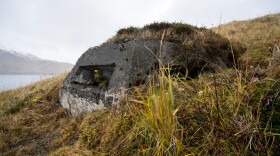-
Residents reported changing where they pick berries and plants, and where they hunt birds and fish. Some have stopped harvesting salmon and marine invertebrates entirely.
-
For this episode of “Island Interviews,” KUCB’s Sofia Stuart-Rasi sat down with Faith Green, project manager on the FUDS research project, to discuss what the team has learned so far and why this research is important for everyone who calls Unalaska home.
-
The findings are part of a growing body of work showing that even in far-flung parts of the Arctic, plastic pollution is deeply embedded in the ecosystem.
-
Scientists have long thought that the genetic diversity of the Alaska red king crab fell into three main groups. But researchers recently found that the species should be split into six, maybe even seven, genetically distinct groups.
-
The Unalaska Fire Department extinguished a wind-driven grass fire in Unalaska Valley May 18. The fire was roughly 100 by 300 feet, located near a residential area on Steward Road.
-
A strong parade of storms has been making its way through the North Central Pacific Ocean, and the location of the jet stream has produced colder storms for Unalaska and the Aleutian region this year. That’s according to Rick Thoman, a climate specialist at the International Arctic Research Center with the University of Alaska Fairbanks.
-
Coastal Alaska is on the front lines of climate change. Extreme weather events are becoming more common, and many communities along Alaska’s shores wonder if the future will bring more of the same. A group of researchers tries to answer what storms might look like in the future by turning toward the past.
-
The Unalaska Learning Center is hosting a grand opening for its new building this weekend. Part of the University of Alaska Fairbanks’ Bristol Bay campus, the center was previously located next to the high school’s woodshop. Now, it’s in the former alternative education building. "We have this large open space — much more welcoming," said Jill Spetz, instructional services manager for the center.
-
A collection of 50-year-old audio recordings from the Aleutians have been digitized and are now accessible online.The recordings were part of an Unalaska school project from the ‘70s. A group of students and their teacher recorded various Elders in hopes of documenting the language, culture and history of the Unangax̂ community and the Aleutian region.There’s about 60 reel-to-reel audio tapes that make up the collection. They include topics from day-to-day activities to historic events, fishing stories and recipes, to accounts from Makushin and the other lost villages that were forcibly evacuated during World War II.
-
A mid-September storm caused major damage in parts of Western Alaska. In Unalaska though, it brought strangely warm temperatures and a warning sign about future storm activity in the region. Wreckage from the historic storm spans about 1,000 miles of coastline from the Lower Kuskokwim area, up north to the Norton Sound region. Flooding and strong winds caused power outages, road and home damage and destroyed subsistence harvests and the means to replace those. While Unalaska was preparing for similar conditions and possible devastation, locals got lucky as the storm passed further west, near Shemya Island. Rick Thoman, a climate specialist at the University of Alaska Fairbanks, said the high seas and strong winds were the remnants of Typhoon Merbok. And while they missed the Eastern Aleutians, they did push subtropical air into the region.

Play Live Radio
Next Up:
0:00
0:00
Available On Air Stations










